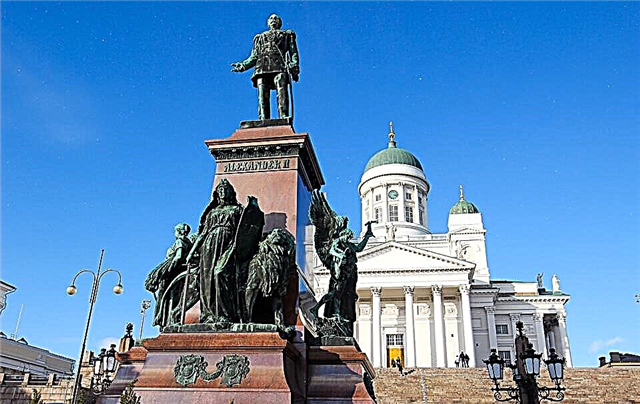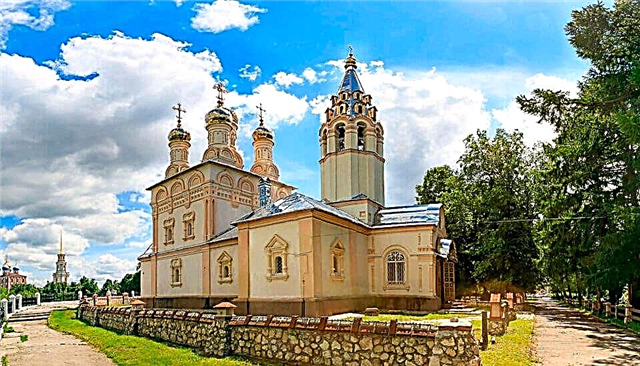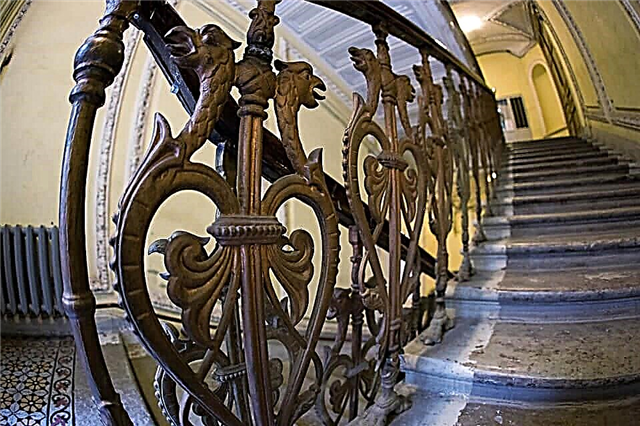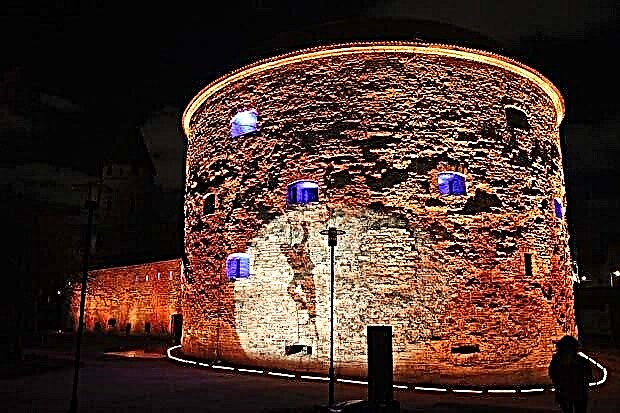This unique church in the city center stands out from other cathedrals and temples of Kazan. The ancient cathedral in honor of the apostles Peter and Paul is a unique architectural monument of the magnificent Peter's baroque. The old church has a difficult history and keeps many Orthodox shrines.
How the temple was built
According to the documents, it is known that a beautiful wooden church has stood on the site where the Peter and Paul Cathedral is now located. The history of the construction of the stone church is associated with the name of the Russian Emperor Peter I.

Peter and Paul Cathedral in Kazan from a bird's eye view
The Tsar visited Kazan several times. The first time this happened in 1695, when the young Peter I led the Russian army's campaign against Azov. Then the king came to the city after 13 years. This time the emperor took part in the creation of the Kazan Admiralty, the largest on the Volga.
During his third visit in May 1722, the sovereign stayed in a two-story stone mansion owned by the merchant and philanthropist Ivan Afanasyevich Mikhlyaev. The house of a well-known owner of a large cloth manufacture in the city stood not far from the wooden Peter and Paul Church.

In Kazan, the tsar celebrated his 50th birthday. In memory of this solemn event and in gratitude for the emperor's trust, the merchant decided to build a new stone church in his hometown. Mikhlyaev dreamed of a church that would surpass all Kazan temples in size and luxury of decoration, and zealously got down to business.
In the times of Peter the Great, many churches were built in the country in the new Russian baroque style. In Nizhny Novgorod, an elegant, richly decorated Christmas church, and in the estate Trinity-Lykovo, which is near Moscow - a spectacular temple of the Life-Giving Trinity.

The fashionable baroque style was chosen as the main one for the temple in Kazan. The building was built relatively quickly - in 4 years. As a model, the builders took the typical for the province posad temples, which were built more than once in the city itself and in the villages near Kazan. However, this project did not take into account the enormous dimensions of the cathedral, so one night the vault of the temple could not withstand the load and collapsed.
When the tsar found out about what had happened, he sent Moscow architects to Kazan. Art critics suggest that Florentine masters also went to the Volga city with the Russians. In a short time, they completed the construction. In 1726, the Kazan temple was consecrated, and church services began to be held here. Unfortunately, the names of the architects and builders of the cathedral have not survived.

The history of the cathedral in the XVIII-XX centuries
The high temple was on fire several times. It received the most severe damage in the middle of the 18th century, in 1815 and 1842. During the Pugachev uprising, the church of Peter and Paul was plundered.
The damaged temple was restored by the whole world. Parishioners and church leaders showed particular zeal in this. With the money collected by the people, the borders were rebuilt, the iconostasis and icons on iron sheets, which adorned the facades of the church, were restored.

In 1864, residents of the city donated a large sum for the capital restoration of the interiors of their beloved cathedral. With these funds, the craftsmen made new carvings on the iconostasis, painted icons and replaced the stucco molding lost during the fires.
In the 1889-1890s, a complete restoration of the building's facades was carried out. The walls of the cathedral and the bell tower were placed on a new stone foundation. The builders rebuilt the two-story northern border from bricks. The gallery was decorated with intricate tiles, multi-colored glass was inserted into the windows. At the same time, the courtyard was paved with cobblestones, and stove heating was made inside the cathedral.

The most famous Orthodox church in the city enjoyed the attention of everyone who came to Kazan. Many Russian tsars, public figures, ministers and writers attended services in the cathedral. Alexander Dumas and Alexander Pushkin wrote about the beautiful temple.
After the revolution, the church was not closed to believers. When an active anti-religious campaign began in the country, the rector of the church, Andrei Bogolyubov, was arrested. The authorities learned that the archpriest had asked the emigrated to China church head to help the cathedral with money. For this he was accused of activities against the Soviet state, convicted and sent to a camp. They did not even take into account the fact that the clergyman came from an ordinary peasant family and was already 67 years old.

In the 1930s, churches in the city were closed one after another, so believers from the Georgian Church, Feodorovskaya and Kazan-Mother of God monasteries began to come to the Cathedral of Peter and Paul. People brought here miraculously saved icons, banners and church utensils.
The city authorities wanted to close the church and give a solid stone building for a book depository, club or anti-religious museum. Finally, in 1939, the building was converted into a party archive. At the same time, the looters plundered the tomb of the temple's ktitor, the merchant Mikhlyaev. Since the 1960s, the former cathedral has housed a planetarium, workshops for restorers, a billiard room and a conference room.

The cathedral was returned to believers one of the first in the city - in the late 1980s. In 1989, the long-suffering temple was consecrated. The old church looked deplorable and in some places was a real ruin. It took a lot of time and effort to put it in order. Professional restorers and builders removed the rubbish, restored the brickwork, fixed the roof, recreated the destroyed facades and carvings on the iconostasis of the temple.
Architectural features
The Orthodox pearl of the capital of Tatarstan is a real decoration of the city! The luxurious temple stands on an elevated place and is therefore visible from afar. The original decor and bright coloring of the facades distinguish it from the surrounding buildings. The majestic baroque temple has many theatrical effects that are made to impress the audience. It is no coincidence that all the guests of Kazan admired and continue to admire the Cathedral of Peter and Paul!

Initially, the entrance to the temple was located from the side Spasskaya Tower... It is from the north that the main facade of the cathedral is located. Then this part of the city was built up with houses, and today people enter the church from the south.
From the northeastern side, a slender six-tiered bell tower with a height of 49 m adjoins the temple. The multi-colored decor of the tall building is in no way inferior to the design of the cathedral. The bell tower windows are decorated with graceful kokoshniks and colored tiles. In pre-revolutionary times, 10 bells hung on the bell tower, the largest of which weighed 189 pounds, that is, almost 3100 kg.

To the west of the temple stands the oldest civil building in the city - the stone mansion of the merchant Mikhlyaev, which was erected in the 17th century. This is exactly the house where Peter I stayed in 1722.
Interiors and shrines
The views of everyone who entered the temple are attracted by the huge majestic iconostasis. It has a height of 25 m and is divided into 7 tiers. The iconostasis and the Royal Doors are covered with exquisite gilded carvings, and the faces of the saints are surrounded by an iridescent gold background.

The main shrines of the cathedral are the icons of the Apostles Peter and Paul, the Meeting, the Mother of God "Life-giving source", "The warrant of sinners" and "Burning bush". The relics of Christian saints are kept in the upper church, and the relics of Metropolitan Ephraim, from whom the army of Kuzma Minin and Dmitry Pozharsky received a blessing, are kept in the lower church.
Useful information for visitors
The church is active, and its doors are open to believers and tourists from morning to evening. The Kazan temple has the status of a cathedral. The entrance is free.

On weekdays, services are held at 8:15 am and 5:00 pm, and on Sundays at 7:00 am, 8:40 am and 5:00 pm. There is a shop on the territory of the temple where they sell church utensils and Orthodox literature.
Tourists are asked to respect the feelings of believers and observe traditions.To visit the temple, women need to have a long skirt, closed shoulders, and a covered head. Inside the building, visitors should not speak loudly. It is better to turn off mobile phones.

How to get there
The temple stands on Musa Jalil Street, 21. In the pre-revolutionary years it was called "Peter and Paul". Kazan's iconic landmark is easily reachable on foot from the Kremlevskaya metro station.
Attraction rating:











